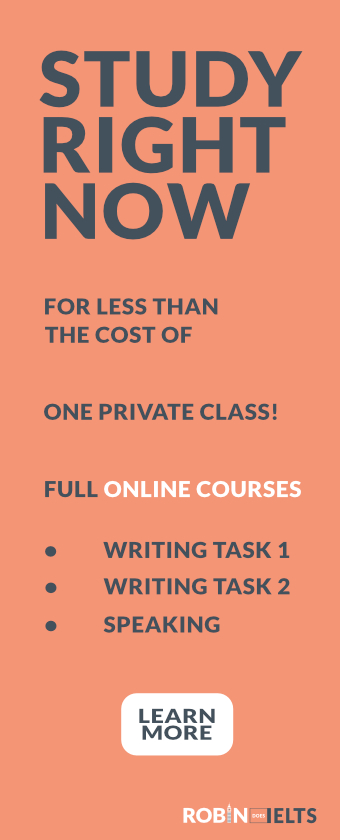
Grammar for Process Diagrams – Part Four
This lesson explains another technique for improving grammar and vocabulary scores when describing process diagrams in IELTS Task One.
Active and passive tenses
Using a range of sentence forms is not easy in process diagrams. There is unlikely to be a change in the time period so using a range of tenses can be quite difficult. For this reason, test-takers should switch between active and passive voices to provide more variation.
Active vs passive
The passive voice is commonly used to describe a process because often what happens is more important that who/what did it.
An active voice follows a simple subject – verb – object structure.
Active - The baker baked the cake in the oven at 180ºC.
Passive voice moves the object before the main verb and tells the reader what happened to it.
It becomes object – be – verb – subject.
Passive - The cake was baked in the oven at 180ºC by a baker.
Passive voice is useful because it can help focus the reader on the important part of the sentence, and remove the doer if it is unnecessary. This cannot happen in active voice. Read the sentences below where the subject has been removed.
Active - Baked the cake in the oven at 180ºC. ✘
Passive - The cake was baked in the oven at 180ºC. ✔︎
When should you use the passive voice?
A passive voice uses the be + past participle structure.
Read these sentences from a baking process. Does this read easily?
First, the baker must put butter and sugar into a bow and mix the ingredients together. When they form a paste, the baker adds eggs, flour and milk. The baker then puts the mixture into a pan and places it in an oven which cooks the mixture at 180ºC for 30 minutes. When the cake is ready the baker can take the finished cake out and serve it hot.
Now read the same process below but with some passive forms included.
First, butter and sugar are put into a bowl and mixed together. When they form a paste, eggs, flour and milk are added. The baker then puts the mixture into a pan, which is placed in an oven and cooked at 180ºC for 30 minutes. When the cake is ready the finished cake can be taken out and served hot.
In the second example, the baker is removed from most of the process because he/she is unimportant. It is the ingredients and the actions that matter. This is the same for many processes in IELTS, especially processes involving manufacturing.
Read these sentences from the model essays found here. Who or what did the actions in bold?
The water is pumped into a third cleaning tank that contains three levels of filtration.
The brick paste is compressed and pushed though a brick-shaped hole, where it is cut into size using a cutting wire.
At the same time, water is released from both the soil and trees through the process of evapotranspiration
This often happens when clouds are forced into higher and colder air over mountains.
In the first two examples some kind of machine does the actions but the machine is not mentioned. This makes sense if the reader knows it is a machine, or it is simply not important to the understanding of the process.
Below is a full paragraph from the model essays.
Initially, in the first step, in order to prepare the raw materials needed for brick-making, clay is excavated, cleaned and weathered for several months. This clay is subsequently crushed through a grill before being combined with sand and water to make a paste. In the third stage, the brick paste is compressed and pushed though a brick-shaped hole, where it is cut into size using a cutting wire.
In this process the writer does not think it is important to know who excavates, cleans, weathers, crushes, combines, compresses or cuts the clay and brick paste, so the choice has been made to remove the doer.
When should you use the active voice?
It is important to remember that in many cases the doer is important (or rather, not unimportant). In these cases the active is most appropriate.
For example, the previous sentences can be written to include the machine if it is a specific type or is important to know.
A pump moves the water into a third cleaning tank that contains three levels of filtration.
A machine compresses the brick paste and pushes it though a brick-shaped hole, where a cutting wire cuts it into size.
Perhaps it is important to know that a pump moves the water. Perhaps it is important to know that the brick paste is not compressed by hand.
Now consider these descriptions of natural processes using active voice.
Initially, water from lakes, rivers and seas evaporates and moves in an upward direction. At the same time, the soil and trees release water through the process of evapotranspiration, adding to the total water vapour rising from the earth’s surface. As it rises, water vapour condenses over sea and land to become clouds.
There is no need for a passive voice here because there is no need to place an object first or to remove a doer. Water evaporates. Trees release water. Water vapour condenses.
In the second paragraph for this model answer, the passive is used once.
Now that clouds have formed, the water vapour can further condense around particles of dust to become rain. In order to form snow, the cloud temperature must be equal to or less than zero degrees Celsius. This often happens when clouds are forced into higher and colder air over mountains. The rainfall and snowmelt returns to the water sources by either surface water running above ground or groundwater below the surface. The process will then begin again.
Why are clouds forced higher? Wind? Air pressure? Is it important to the writer in this process? Using a passive here shows that the clouds don’t force themselves higher, but that the doer is not clear or necessary.
A well-written IELTS process diagram description will contain both active and passive voices, but remember that a manufactured process is likely to have a lot more passive voice. Read the model essays included with this course and notice how both voices are used.


